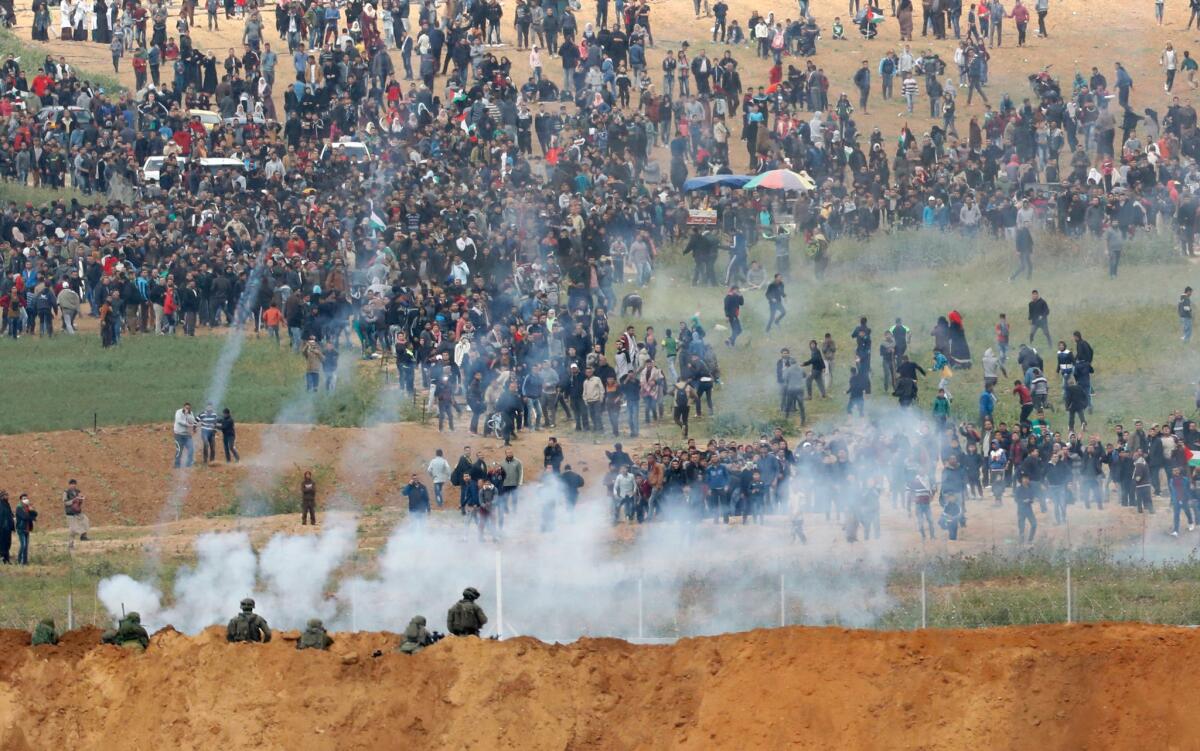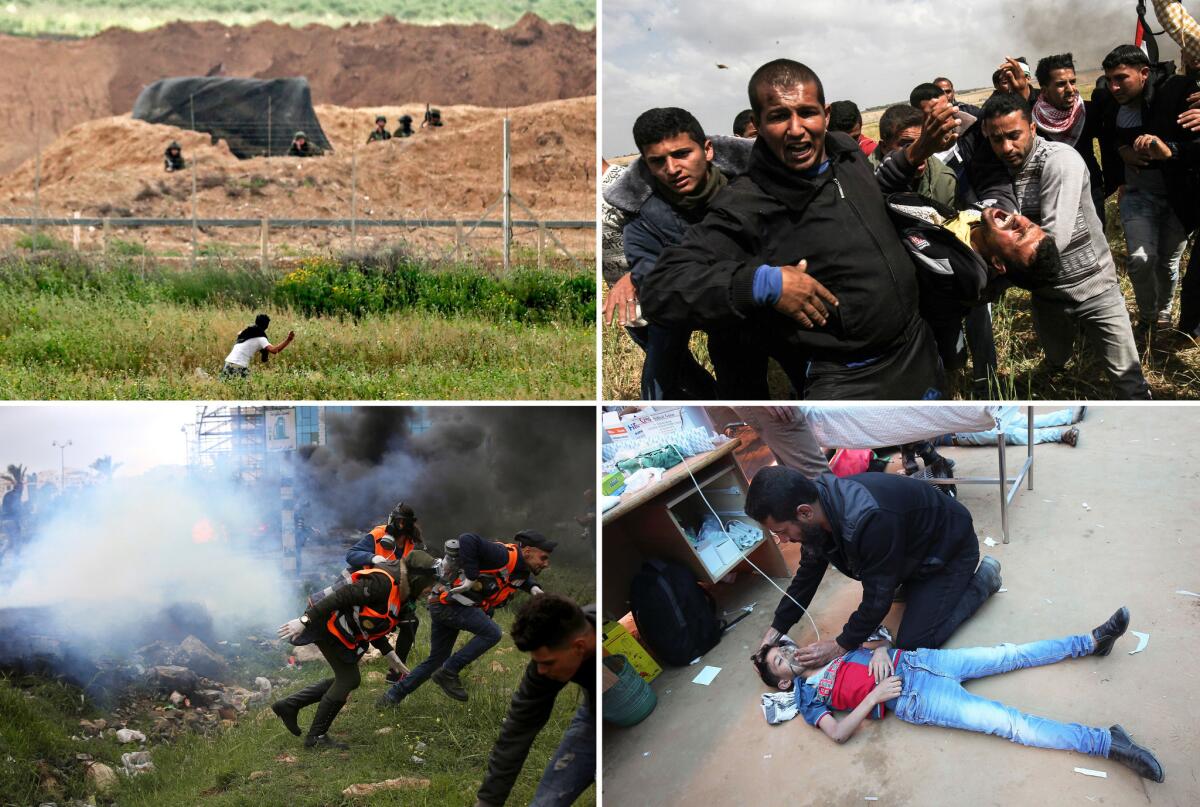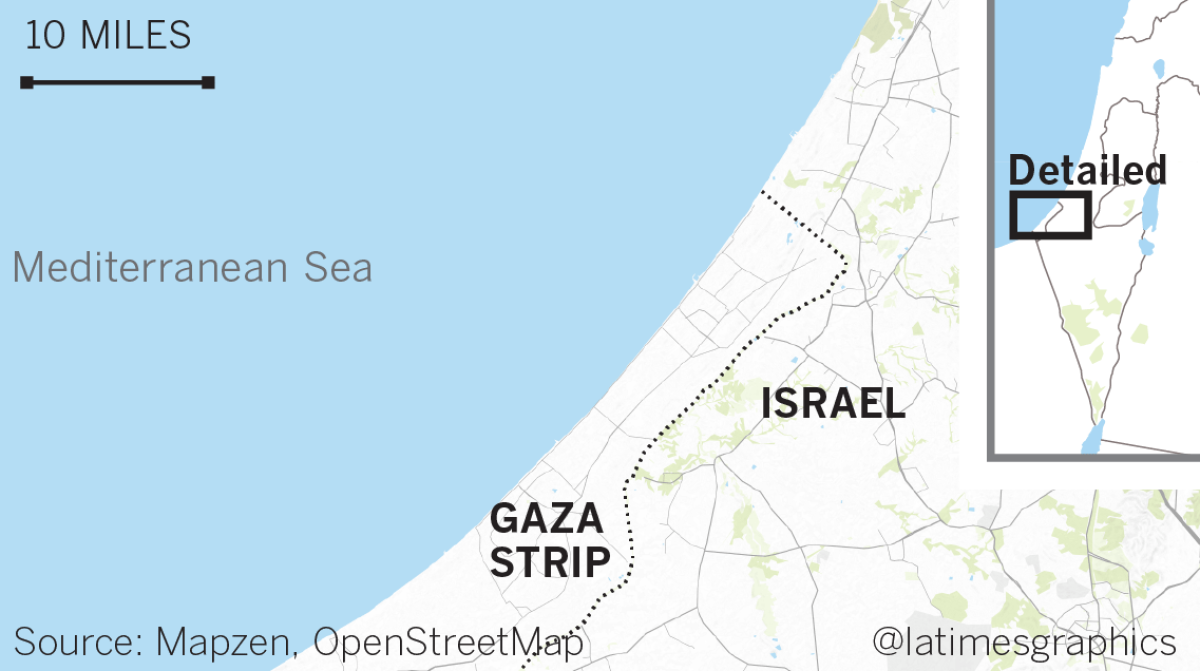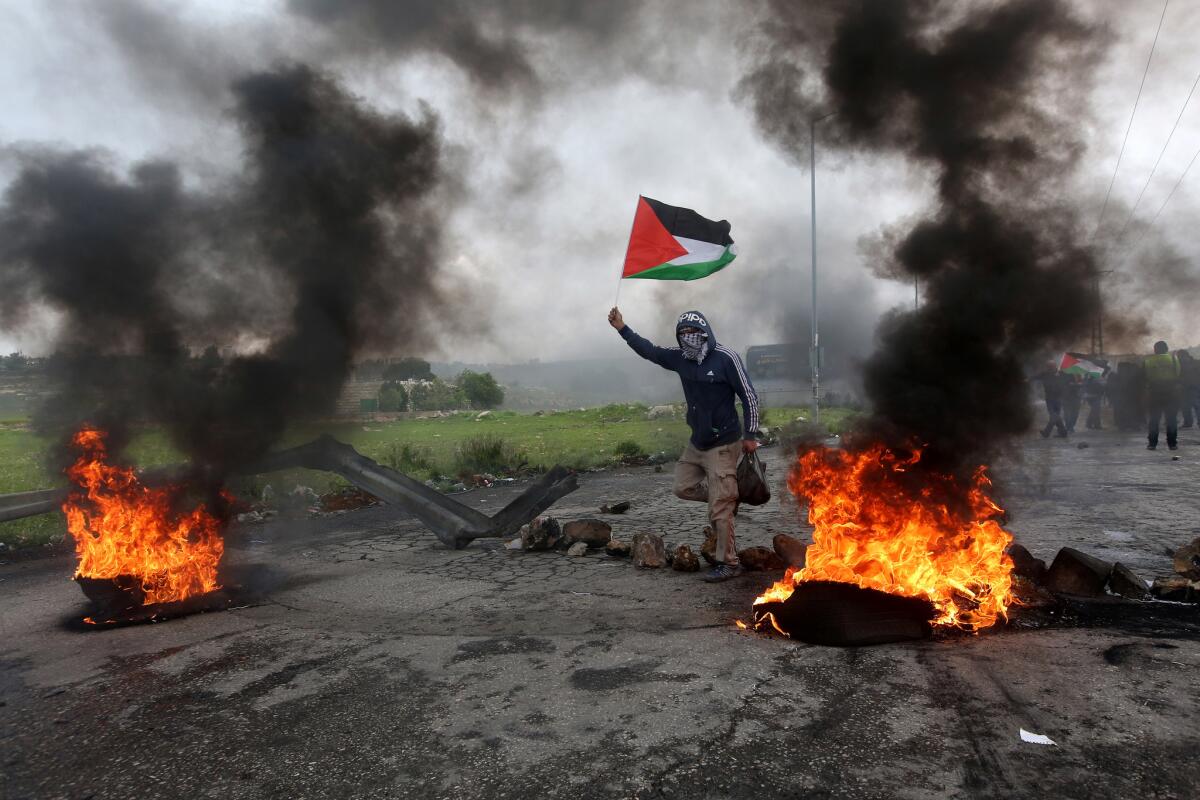15 Palestinians reported killed by Israeli fire as Gaza border protest builds

- Share via
A long-planned campaign of nonviolent protests in the Gaza Strip along its border with Israel degenerated into mayhem and bloodshed almost from the start on Friday, with the Palestinian health ministry reporting 15 dead and hundreds wounded in clashes with the Israeli army.
Friday’s protests marked Land Day, when Palestinians observe the date in 1976 that six unarmed Arab citizens from Israel were killed in a wave of protests against state expropriations of land.
It launched six weeks of protests that are planned to culminate in a march on Israel’s border in mid-May, around the date commemorating the 70th anniversary of Israel’s founding and, this year, the start of the Muslim holy month of Ramadan.
Palestinians in the Gaza Strip began the protest to demand the right of Palestinian refugees to return to their homes in what is now Israel.
Israeli and Palestinian sources reported there were around 20,000 protesters, many of whom were bused into the area along Israel’s border fence.

The Israeli military said rioting was taking place in five locations along the fence, with burning tires rolled toward Israeli soldiers, and firebombs and rocks hurled beyond the fence.
In a statement, the Israeli army said it was “responding with riot dispersal means and firing towards main instigators.”
Israeli forces reportedly used live ammunition, rubber bullets and tear gas.
The head of Israel’s Southern Command, Maj. Gen. Eyal Zamir, warned that militants were using the cover of riots to plant explosives “for terror attacks” along the border fence.
In preparation for the unrest, Israel more than doubled the usual number of troops stationed along the border, deploying drones, sharpshooters and elite army units. Israeli officials repeatedly warned they would prevent any breach of the border or violation of Israel’s sovereignty.
The entire area surrounding the Gaza Strip was declared a closed military zone.

The series of protests was planned by Hamas — the Palestinian Islamist militia ruling Gaza, which is considered a terror group by the United States, Europe and Israel — to mark the rare confluence of Land Day and several other events.
In six weeks, Palestinians mark the Nakba, or catastrophe, as Israel’s establishment is referred to by Palestinians, and the move of the U.S. Embassy to Jerusalem, scheduled for that date, that was announced as part of President Trump’s December declaration of U.S. recognition of Jerusalem as Israel’s capital, without mention of Palestinian claims to the eastern half of the city.
Friday’s demonstration is also protest against Israel’s more than decade-long blockade of Gaza, an enclave of 2 million people locked between Israel, Egypt and the Mediterranean Sea, that curtails the movement of people and goods. Israel has claimed the siege is necessary to guarantee its own safety since Hamas wrested control of the territory from the Palestinian Authority in a 2007 coup.
The protest, dubbed the March of Return, was framed as a Palestinian demand for the right of return to the area that became Israel 70 years ago.
A majority of Gazans are the descendants of refugees of the 1948 war that erupted at Israel’s creation.

Members of Hamas’ top leadership milled about among the demonstrators, encouraging the protests and, at least implicitly, flaunting the rally’s success to the Palestinian Authority, the internationally recognized governing body based in the West Bank city of Ramallah.
Ahmed Helles, a member of Fatah Central Committee, the ruling party that attempted to reunite with Hamas last October in an effort that has since stalled, said, “The Fatah movement is here like other factions, and this is a national day with distinction and all colors today mixed with the color of the Palestinian flag.”
“This march confirms that the right of return is the essence of the struggle of our people since the occupation of Palestine,” he said. “Today, the people affirm that this principle and goal is in place and all the challenges facing our people will only increase our determination to uphold the right of return.”
Hamas leader Ismail Haniyeh, addressing demonstrators, said, “Today's march is the beginning to return to the land of historic Palestine, and our people say to Trump: No concession of Jerusalem or Palestine and no solution without the right of refugees to return to their towns and villages. No recognition of Israel or the occupation rights in any inch on our land.”
Palestinian Authority President Mahmoud Abbas declared Saturday a day of national mourning in honor of the Palestinians who died in the clashes.
Near a small gray tent erected east of Jabaliya in northern Gaza, Khalil Abu Qammar, 68, a retired U.N. schoolteacher, stood waving a Palestinian flag alongside his two sons and five grandsons. Around them, not far from the Israel border, young children sang the national anthem.
“I’m from Jaffa,” he said. “My father, mother and grandfather were born there. I still have the key for my family home in Jaffa, and whoever is living there will have to pack up his bag and leave. I won't accept any solution that does not grant me my rights to return to my father’s hometown.”
Beside the tents Hamas asked Gazans to set up at the border — a symbol of their intention not to move until their demands are met — families wrote down the names of the villages and towns their families were from, villages now inside Israel.
Khadrah Zaqout, 76, was busy baking a fresh, homemade loaf of bread in a mud oven that provides for her family of nine. She said she intends to remain all day in the tent to demand her right to return to her home city, which was abandoned in 1948 when the state of Israel was established.
“I am from the city of Majdal [Ashkelon], where I was born and lived the most beautiful days of my life,” she said. “I still remember our beautiful house, the olive tree and the chicken coop.”
“I brought my grandsons with me to the protest to show them the way to their historical homeland, the land of Palestine," she said.
Special correspondents Tarnopolsky reported from Jerusalem and Abu Alouf from Gaza City.
UPDATES:
1:10 p.m.: This article was updated with comments from Palestinians camped in tents near the border and a revised death toll of 15 in Gaza.
7:20 a.m.: This article was updated throughout with staff reporting, including a revised death toll of nine in Gaza.
6:05 a.m.: This article was updated with a revised death toll of six in Gaza.
This article was originally published at 5:05 a.m.
Sign up for Essential California
The most important California stories and recommendations in your inbox every morning.
You may occasionally receive promotional content from the Los Angeles Times.







